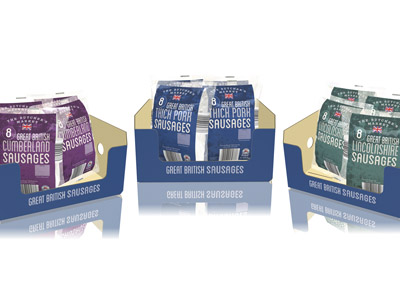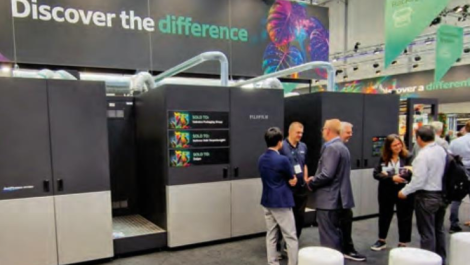Ian Schofield, own label & packaging manager of Iceland Foods
Interview with Ian Schofield, own label & packaging manager, Iceland Foods.
At the end of Ian Schofield’s first stint in looking after Iceland’s own-label offer in 1992, digital print was still not much more than a figment of its visionary founding father’s imagination. By the time he returned to the fold 21 years later – in the interim having been a prime mover in repositioning the pre-press sector as the guardian of colour management, plus setting up one of the UK’s largest independent flexo printers (now part of the Interflex Group) – the technology was now boldly going where no other processes had
gone before.
Proving that end users can be just as effective as print service provider adopters when it comes to converting others to the cause, Ian Schofield charts how his digital journey has helped to establish the technology’s credentials and capabilities in the eye of the consumer. By Des King.
When and why did you first extend into digital print?
I became aware of it as a serious alternative to conventional print in terms of quality and reproduction during my time in the pre-press sector; not least as Sun were busily developing inks for it. That was five or six years ago, but when I rejoined Iceland and jumped to the other side of the ship as a buyer rather than a supplier, then obviously I started to look for advantages it might be able to give us in terms of differentiation from the other retailers.
What were the main challenges that had to be addressed?
We first used digital for a range of chilled own-label sausages produced in four different lines, and that we launched in under a week; so clearly, time to market was the most immediate challenge. In terms of quality it worked really well as to everyone else in the business it appeared to all intents and purposes no different from flexo. For anyone who wondered whether going digital was taking a big risk, we were able to point out that we’d printed a lot of packs that were already on the shelves digitally, but had deliberately not told them.

A range of chilled own-label sausages in four different lines was brought to market in under a week as Iceland’s first product with digitally printed packaging (Ultimate Group)
The main outstanding challenge, however, always has been in the finishing department; the cutting and gluing and all those other things that still have to be done conventionally offline. Right from the outset, labels represented a far more straightforward proposition; that’s why it was the sector that the digital press manufacturers first targeted, and so successfully too.
What have been the main gains achieved through digital printing?
Lower inventory levels and personalisation. Print runs are coming down and we never print the same job twice. We have a lot of text on the packaging sometimes – everybody does – and you don’t want too much stock. If you can print what you need, for say only the next week, then obviously you can make it much more personal/current/topical to that particular job. You can see where the future’s going on this.
As a business we’re doing more and more events – seasonal ones such as Halloween and one-offs like the Queen’s birthday – and you can now print stuff that you just wouldn’t have even considered before. Even though our volumes generally are really big these days, there’s still plenty of scope for personalisation on the packaging. Hitherto, there was only one route to go; now there’s the option of digital or conventional.
There’s no cost saving; in fact, on a like for like basis compared to conventional, it’s usually more expensive at the moment. Obviously, however, the biggest benefit is in not having to do the plate changes on flexo jobs; that can result in a significant saving on short runs. Up until now there hasn’t been that much difference in cost between conventional and a digital press, but with more and more new systems coming on to the market, the capital investment required is now starting to reduce as the competition between manufacturers intensifies.
What proportion of your own-label offer is printed digitally, and how is that likely to change in the future?
Currently, it’s about 5% in flexibles and labelling applications within our own-label offer, mostly across the frozen and chilled sectors. The balance is split pretty much evenly between flexo and litho.
You’ve got to bear in mind that we are big runners; volumes of 100,000+ would be difficult to justify as digital. But as we go into more and more niche products, then it becomes increasingly viable. And as the cost of equipment becomes cheaper, the amount of work going digital will definitely expand. In my mind I have absolutely no doubt that the entire retail sector will have a high percentage of digital in the future; it’s going happen. In terms of our own offer, I could see that 5% be more like 50% in even maybe five years’ time.
Are your customers aware of any benefits that digital print brings them?
They are inadvertently part of this process by virtue of some of the more obvious plus points it provides – for example, the use of personalisation on pack – so I guess they are involved with it whilst not being aware of the how and why. We are, however, going to see that more and more, so they will be in the future but not yet. Likewise, as some of the objectives being addressed via the Courtauld commitment become more readily understood at consumer level – viz less food and packaging waste – then there will be an appreciation of the reasons and benefits accrued by only printing what’s needed.
How much of a role does digital print play in supporting your online business?
Since it was re-launched in 2013, online retail now represents a high percentage of our overall business; a core competence that we were delighted to have recognised earlier this year when we were voted Britain’s best online retailer according to the Which? annual supermarket survey. Of course, there’s a role for digital in this space; it doesn’t take a rocket scientist to work that one out. We’re not doing it yet – and I don’t want to give any secrets away – but you can see what’s coming: we all respond positively to personalisation and so why not have customers receive almost bespoke packs with their name on delivered direct to the door.
How would you advise other retailers or brand owners considering whether to adopt digital print?
For anybody who’s in any packaging position, whether that’s with a brand owner or a retailer it’s definitely got advantages; you’d be daft not to look at it. Yes, it’s just another way of printing – but it’s one that brings with it some key advantages. Digital has changed everything in any number of other industries, and it’ll be just the same in packaging. Indeed, in 10 years’ time it wouldn’t be a surprise were there to only be the one method of printing, and that might well be digital. Of course, everyone’s looking at which is the most commercial way in which to get the job printed, but bit by bit it’ll automatically go digital because all those attributes that it uniquely offers will be required without saying.
How do you see the future for digital print in packaging?
The pioneer digital technology developers, such as HP, have obviously invested heavily in the process to attack the traditional flexo and litho markets. As well as the heavy level of advertising they’ve put behind it there’s been a lot of end-users’ involvement, and now there are more and more printers coming onto the scene. Indeed, if a converter hasn’t yet added a digital press to their production capacity then they’ll almost certainly be looking at doing so; it’s just a matter of when. The technology is coming down in price. I think that within the next two years virtually every converter will have a digital press in house.
In the meantime, everyone’s now into the market with different digital presses. We’re not necessarily wedded to any particular process, and there’s any number of very clever people out there looking at ways in which to address the situation, be it toner-based, inkjet, or who knows Landa’s nanotechnology, although I don’t think it’s been proven yet. But it’ll all add up to a mix that’s available to us end users to enable us to realise the best option open to us.
We live in a digital world with a digital mindset. Digital print is a foregone conclusion. Did you ever think that your desktop printer at home could do all the things it now can as a matter of course? Well exactly the same is starting to happen with print on packaging. There used to be all this black art about colour management but that mystique is going really quickly; it’s being deskilled. We can now virtually send something from scratch straight to press.
Anything can now quite literally happen in the next half hour; that’s the digital reality.






